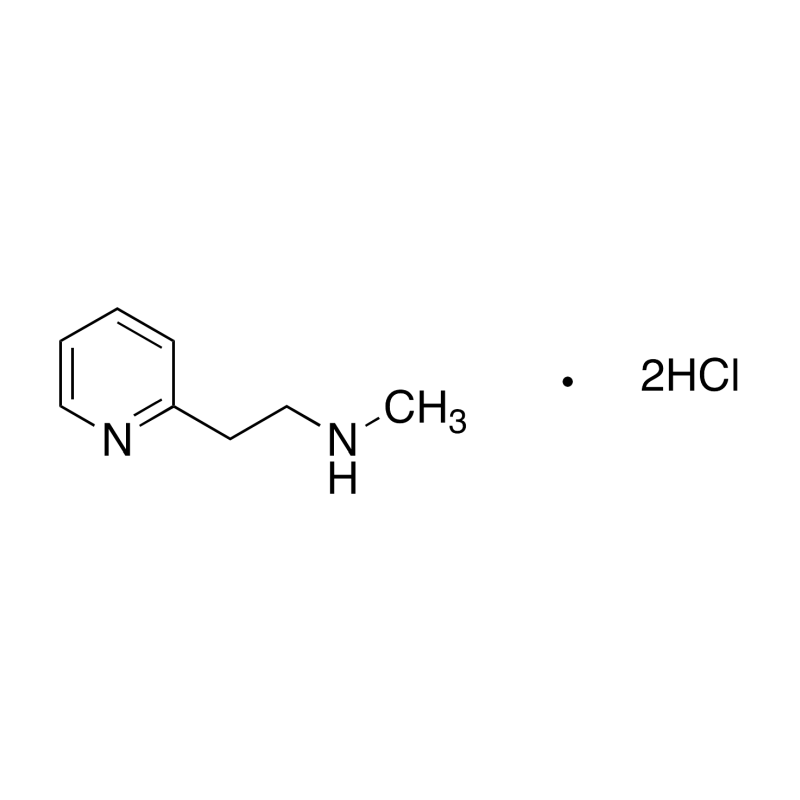产品
编 号:F389653
分子式:C8H14Cl2N2
分子量:209.12
分子式:C8H14Cl2N2
分子量:209.12
产品类型
规格
价格
是否有货
10mM*1mL in DMSO
询价
询价
1g
询价
询价
5g
询价
询价
结构图

CAS No: 5579-84-0
产品详情
生物活性:
Betahistine dihydrochloride is an orally active histamine H1 receptor agonist and a H3 receptor antagonist. Betahistine dihydrochloride is used for the study of rheumatoid arthritis (RA).
体内研究:
Betahistine dihydrochloride (intraperitoneal or oral administration; 0.1-30 mg/kg; single dose) with acute administration has increased tele-methylhistamine (t-MeHA) levels with an ED50 of 0.4 mg/kg, indicating the inverse agonism. Besides, after acute oral administration, it increases t-MeHA levels with an ED50 of 2 mg/kg in male Swissmice.Betahistine dihydrochloride (oral adminstration; 1 and 5 mg/kg; daily for 3 weeks) attenuates the severity of arthritis and reduces the levels of pro-inflammatory cytokines in the paw tissues of CIA mice.Animal Model:Collagen-induced arthritis (CIA) DBA/1 male mouse model
Dosage:1 mg/kg; 5mg/kg
Administration:Oral adminstration; day 21 to day 42 after a 21-day CIA induction
Result:Ameliorated mouse CIA by decreasing joint destruction.
体外研究:
Betahistine dihydrochloride (0-10 μM) inhibits [125I]iodoproxyfan binding to membranes of CHO (rH3(445)R) and CHO (hH3(445)R) cells with IC50 values of 1.9 μM and 3.3 μM, respectively. Lead to Ki values of 1.4 μM and 2.5 μM, respectively.Betahistine dihydrochloride (0-10 μM) has a regulating function on cAMP formation in CHO (rH3(445)R), CHO (rH3(413)R), and CHO (hH3(445)R) cells. At low concentrations, betahistine behaves an apparent inverse agonist, and progressively enhances cAMP formation with EC50 values of 0.1 nM, 0.05 nM and 0.3 nM, respectively. In contrast, at concentrations higher than 10 nM, betahistine inhibits cAMP formation with an EC50 value of 0.1 μM in CHO (rH3(445)R) and full agonist activity.
Betahistine dihydrochloride is an orally active histamine H1 receptor agonist and a H3 receptor antagonist. Betahistine dihydrochloride is used for the study of rheumatoid arthritis (RA).
体内研究:
Betahistine dihydrochloride (intraperitoneal or oral administration; 0.1-30 mg/kg; single dose) with acute administration has increased tele-methylhistamine (t-MeHA) levels with an ED50 of 0.4 mg/kg, indicating the inverse agonism. Besides, after acute oral administration, it increases t-MeHA levels with an ED50 of 2 mg/kg in male Swissmice.Betahistine dihydrochloride (oral adminstration; 1 and 5 mg/kg; daily for 3 weeks) attenuates the severity of arthritis and reduces the levels of pro-inflammatory cytokines in the paw tissues of CIA mice.Animal Model:Collagen-induced arthritis (CIA) DBA/1 male mouse model
Dosage:1 mg/kg; 5mg/kg
Administration:Oral adminstration; day 21 to day 42 after a 21-day CIA induction
Result:Ameliorated mouse CIA by decreasing joint destruction.
体外研究:
Betahistine dihydrochloride (0-10 μM) inhibits [125I]iodoproxyfan binding to membranes of CHO (rH3(445)R) and CHO (hH3(445)R) cells with IC50 values of 1.9 μM and 3.3 μM, respectively. Lead to Ki values of 1.4 μM and 2.5 μM, respectively.Betahistine dihydrochloride (0-10 μM) has a regulating function on cAMP formation in CHO (rH3(445)R), CHO (rH3(413)R), and CHO (hH3(445)R) cells. At low concentrations, betahistine behaves an apparent inverse agonist, and progressively enhances cAMP formation with EC50 values of 0.1 nM, 0.05 nM and 0.3 nM, respectively. In contrast, at concentrations higher than 10 nM, betahistine inhibits cAMP formation with an EC50 value of 0.1 μM in CHO (rH3(445)R) and full agonist activity.
产品资料

